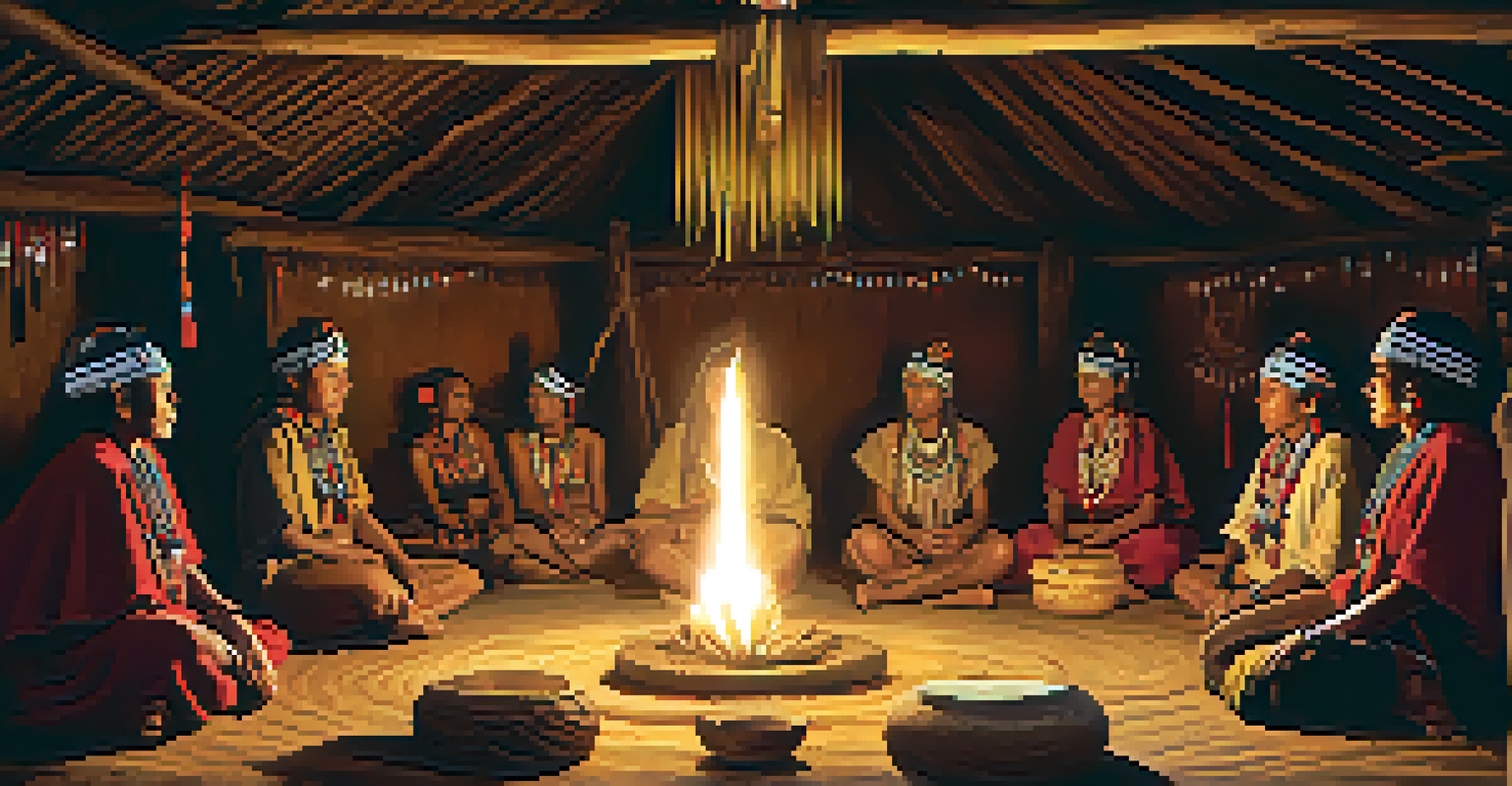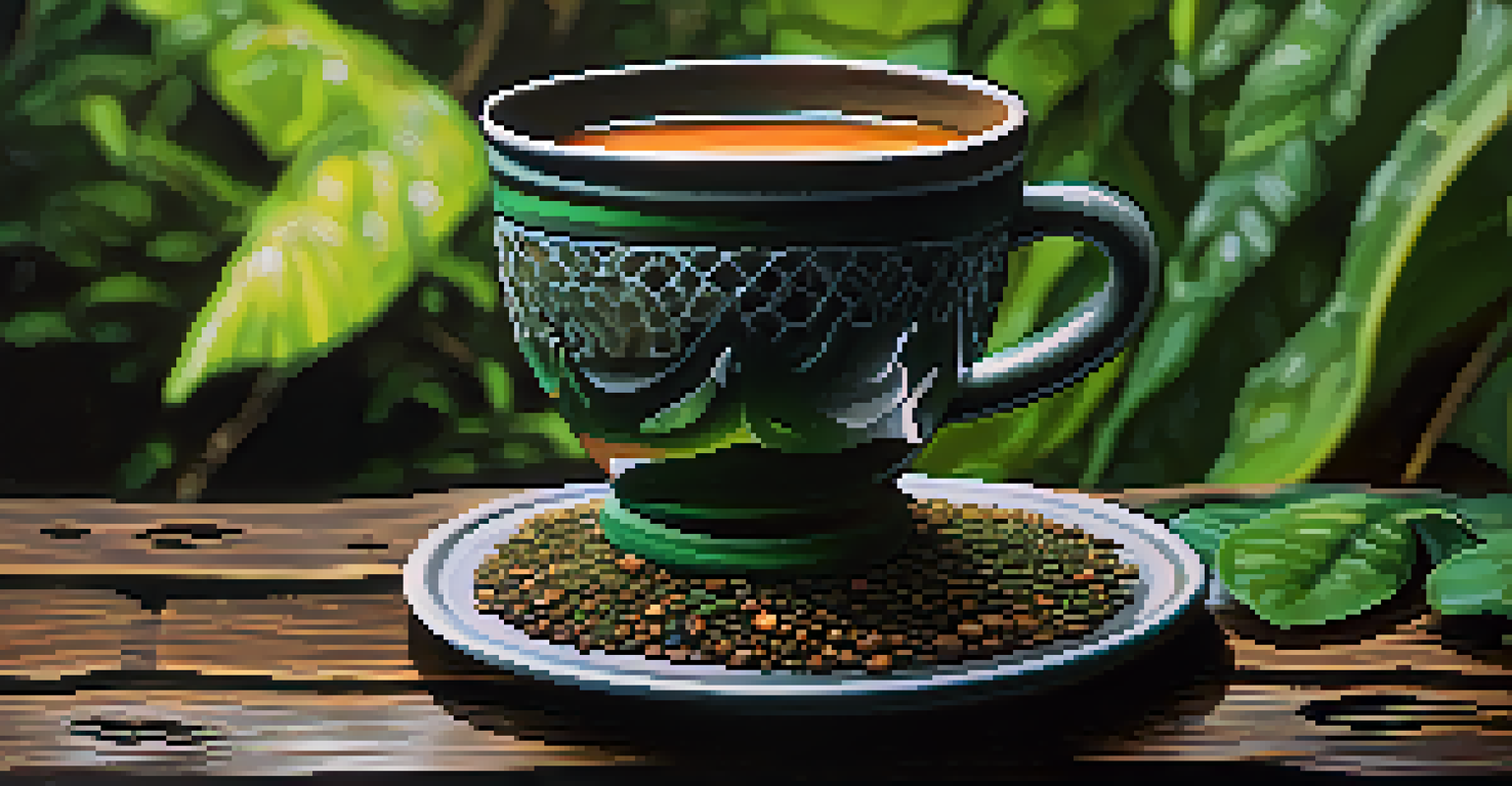The Science Behind Ayahuasca and Mental Health Benefits

What is Ayahuasca and Its Cultural Significance?
Ayahuasca is a traditional Amazonian brew made from the Banisteriopsis caapi vine and the Psychotria viridis leaf. For centuries, it has been used in spiritual and healing ceremonies by indigenous tribes. This unique concoction contains psychoactive compounds that induce altered states of consciousness, which many believe facilitate profound psychological and spiritual insights.
The greatest discovery of my generation is that a human being can alter his life by altering his attitudes.
The cultural significance of ayahuasca cannot be overstated; it is often regarded as a sacred medicine that fosters a deep connection to the spiritual realm. Participants typically join group ceremonies led by a shaman, who guides them through their journey, ensuring a safe and meaningful experience. This communal aspect adds another layer to its healing properties, as individuals share their experiences and support one another.
As interest in ayahuasca grows globally, researchers are examining its potential mental health benefits. This exploration blends ancient wisdom with modern science, raising questions about how traditional practices can fit into contemporary therapeutic frameworks.
The Role of DMT in Ayahuasca and Its Effects
One of the key components of ayahuasca is DMT (dimethyltryptamine), a powerful psychedelic compound. When consumed, DMT interacts with serotonin receptors in the brain, leading to vivid visual and auditory hallucinations. This experience is often described as life-changing, with many users reporting enhanced emotional clarity and a greater understanding of their personal struggles.

Interestingly, DMT is naturally produced in small amounts by the human body, particularly in the pineal gland. This has led to theories suggesting that the compound may play a role in dreaming and near-death experiences. As a result, some researchers believe that ayahuasca could help unlock parts of the mind that are usually inaccessible, promoting healing and introspection.
Ayahuasca's Cultural Importance
Ayahuasca is revered as a sacred medicine in Amazonian cultures, facilitating spiritual connections and communal healing.
However, it's important to note that the effects of DMT can vary widely among individuals. Factors like dosage, the setting of the experience, and personal mindset all contribute to the outcome, making it essential for participants to approach ayahuasca with respect and preparedness.
Ayahuasca's Potential for Treating Depression
Recent studies suggest that ayahuasca may be a promising alternative for individuals suffering from depression. Participants often report significant improvements in their mood and outlook after a ceremony, with some studies indicating long-lasting effects. The brew’s ability to facilitate emotional catharsis could be integral to this process, allowing individuals to confront and release repressed feelings.
Psychedelics can help us understand ourselves in ways that we never would have known otherwise.
A study conducted in 2019 found that participants who engaged in ayahuasca ceremonies experienced a reduction in depressive symptoms, with effects lasting for several weeks. This is particularly notable for those who have not found relief through conventional treatments, such as antidepressant medications. For them, ayahuasca might provide a new avenue for healing.
Moreover, the introspective nature of the ayahuasca experience encourages individuals to reflect on their lives and relationships. This self-reflection can lead to greater emotional resilience, enabling participants to tackle their depression with renewed strength and perspective.
Exploring Anxiety Management Through Ayahuasca
In addition to depression, ayahuasca is being investigated for its potential to alleviate anxiety. Many participants report feeling a sense of calm and clarity during and after their experiences, which can be particularly beneficial for those struggling with chronic anxiety. The ability to confront fears and anxieties head-on in a supportive environment is a crucial aspect of this process.
Research findings suggest that the psychedelic experience can lead to a decrease in anxiety levels, providing individuals with new coping mechanisms. Participants often describe a sense of liberation from their worries, allowing them to approach life with a fresh perspective. This shift in mindset can be instrumental in managing anxiety long-term.
Potential Mental Health Benefits
Emerging research suggests ayahuasca may effectively treat depression and anxiety, offering new avenues for emotional healing.
However, just like with depression, the effects can vary widely. Some individuals may find that the intensity of the experience exacerbates their anxiety rather than alleviating it, highlighting the importance of a supportive setting and skilled guidance during the ceremony.
The Neurobiology of Ayahuasca and Emotional Healing
The neurobiological effects of ayahuasca are a fascinating area of research, particularly in relation to emotional healing. Studies indicate that psychedelics can promote neuroplasticity, which is the brain's ability to reorganize itself by forming new neural connections. This could explain why individuals often emerge from ayahuasca experiences with a renewed outlook on life.
Furthermore, ayahuasca appears to increase brain-derived neurotrophic factor (BDNF), a protein associated with improved mood and cognition. Higher levels of BDNF are linked to enhanced learning and memory, as well as greater emotional resilience. As such, ayahuasca may play a role in not only alleviating symptoms of mental health disorders but also fostering overall brain health.
By understanding these biological mechanisms, researchers hope to develop more effective therapeutic approaches. This could lead to the integration of ayahuasca into mainstream mental health treatment, offering individuals a holistic way to heal and grow.
The Role of Integration After Ayahuasca Experiences
One of the most crucial aspects of ayahuasca therapy is the integration process that follows the experience. Integration involves reflecting on the insights gained during the ceremony and finding ways to apply them to daily life. This is often where the real healing occurs, as individuals learn to navigate their emotions and experiences with newfound understanding.
Many participants benefit from post-ceremony support, whether through group discussions, therapy, or personal reflection. This support can help individuals process their experiences, making it easier to translate the insights into actionable change. Without proper integration, the profound realizations gained during the ceremony may fade away, leaving participants feeling lost or confused.
Risks and Cautions of Use
While promising, ayahuasca use carries risks, including potential interactions with medications and the need for emotional readiness.
Thus, integration is not just an afterthought; it is a vital component of the ayahuasca journey. By prioritizing this process, individuals can ensure that their experiences translate into tangible improvements in their mental health and overall well-being.
Considerations and Risks of Ayahuasca Use
While ayahuasca offers potential mental health benefits, it is essential to approach it with caution. The brew can interact negatively with certain medications, particularly those affecting serotonin levels, leading to serious health risks. Therefore, individuals should consult with healthcare professionals before considering ayahuasca, particularly if they are on medication.
Additionally, the experience can be emotionally intense, and not everyone is prepared for that level of introspection. It’s crucial for participants to evaluate their mental readiness and seek guidance from experienced practitioners. The setting, preparation, and support available during the ceremony can significantly impact the experience.

Ultimately, while ayahuasca has shown promise in improving mental health, it is not a panacea. Individuals should weigh the potential benefits against the risks and approach this ancient practice with respect and thorough understanding.